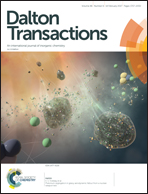The magnetoresistance effect in a conducting molecular crystal consisting of dicyano(phthalocyaninato)manganese(iii) †
Abstract
A conducting molecular crystal TPP[MnIII(Pc)(CN)2]2 (MnIII: d4, S = 1, TPP = tetraphenylphosphonium and Pc = phthalocyanine) was fabricated. In its crystal structure, the [MnIII(Pc)(CN)2] units formed a one-dimensional regular chain along the c-axis with an overlap integral value of 8.6 × 10−3. TPP[MnIII(Pc)(CN)2]2 showed a semiconducting behaviour that also has been observed for isostructural TPP[CoIII(Pc)(CN)2]2 (CoIII: d6, S = 0) and TPP[FeIII(Pc)(CN)2]2 (FeIII: d5, S = 1/2) whose ground states are charge-ordered states. In spite of the local magnetic moment of the MnIII ion (S = 1) at the centre of the Pc ligand, TPP[MnIII(Pc)(CN)2]2 exhibited an almost isotropic and small negative magnetoresistance (MR) effect (the MR ratio was −8.7% under 8 T at 10.7 K), contrarily to the anisotropic giant negative MR effect of TPP[FeIII(Pc)(CN)2]2. The isotropy was found to be due to a (dxz)1(dyz)1 electronic configuration, and the smaller MR effect was explained by a weaker antiferromagnetic interaction between MnIII ions than that between FeIII ions, as suggested by a Weiss temperature Θ of −3.1 K (|Jdd|/kB = 1.2 K).



 Please wait while we load your content...
Please wait while we load your content...